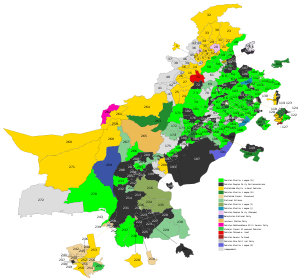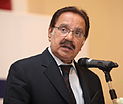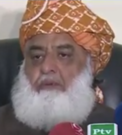Pakistani general election, 2002
| |||||||||||||||||||||||||||||||||||||||||||||||||
All 342 seats to the National Assembly 172 seats needed for a majority | |||||||||||||||||||||||||||||||||||||||||||||||||
|---|---|---|---|---|---|---|---|---|---|---|---|---|---|---|---|---|---|---|---|---|---|---|---|---|---|---|---|---|---|---|---|---|---|---|---|---|---|---|---|---|---|---|---|---|---|---|---|---|---|
| Turnout | 41.8% ( | ||||||||||||||||||||||||||||||||||||||||||||||||
| |||||||||||||||||||||||||||||||||||||||||||||||||
 Results of elections showing political parties.
| |||||||||||||||||||||||||||||||||||||||||||||||||
| |||||||||||||||||||||||||||||||||||||||||||||||||
Pakistan |
|---|
 |
This article is part of a series on the politics and government of Pakistan |
Constitution
|
Government
Parliament
Executive:
Judiciary
|
Elections
|
Administrative units
|
Federalism
|
Foreign relations
|
|
General elections were held in Pakistan on 10 October 2002 to elect the National Assembly of Pakistan and the provincial assemblies. The elections were held under the watchful scrutiny of the military government of General Pervez Musharraf.[1] This elections featured the multiparty democracy as it brought an end to the two-party system between the Pakistan Peoples Party and Pakistan Muslim League (N). A right of center Pakistan Muslim League (Q) emerged in the mainstream political spectrum of Pakistan, that supported liberal President Musharraf.
Around 70 parties took participation in the elections,[citation needed] however, only six parties managed to bag sufficient popular vote namely PML-Q, PPP, MMA, PML-N, MQM and National Alliance.
Parties and candidates
More than 70 parties, contested the election, the main parties were the Peoples Party Parliamentarians, Pakistan Muslim League-Nawaz Group, Muttahida Quami Movement (MQM), Pakistan Muslim League-Quaid-i-Azam also called the "King's Party" for its unconditional support to the government, and the Muttahida Majlis-i-Amal (MMA), alliance of six religious political parties. Other known parties contesting at the national level included the six-party National Alliance led by former President Farooq Ahmad Lagari, Imran Khan's Pakistan Tehrik-i-Insaaf and Tahir-ul-Qadri's Pakistan Awami Tehrik.[1]
Results
| Votes | % | Seats | |
|---|---|---|---|
Pakistan Muslim League (Quaid-e-Azam) | 7,500,797 | 25.66 | 126 |
Pakistan Peoples Party Parliamentarians | 7,616,033 | 26.05 | 81 |
Muttahida Majlis-e-Amal Pakistan
| 3,335,643 | 11.41 | 63 |
Pakistan Muslim League (Nawaz) | 3,409,805 | 11.66 | 19 |
Muttahida Qaumi Movement | 932,166 | 3.19 | 17 |
National Alliance
| 1,395,398 | 4.77 | 16 |
Pakistan Muslim League (Functional) | 328,923 | 1.13 | 5 |
Pakistan Muslim League (Junejo) | 283,755 | 0.97 | 3 |
Pakistan Peoples Party (Sherpao) | 98,476 | 0.34 | 2 |
Pakistan Tehreek-e-Insaf | 242,472 | 0.83 | 1 |
Pakistan Awami Tehreek (Pakistan People's Movement) | 202,845 | 0.69 | 1 |
Jamhoori Wattan Party (Republican National Party) | 96,240 | 0.33 | 1 |
Pakistan Muslim League (Zia-ul-Haq Shaheed) | 78,798 | 0.27 | 1 |
Balochistan National Party | 57,865 | 0.20 | 1 |
Pakhtun-khwa Milli Awami Party | 96,252 | 0.33 | 1 |
| Independents | 2,722,669 | 9.31 | 3 |
| Non-partisans (most joined one of the above parties) | - | 14.1 | 21* |
| Female elected members (included in party seats above) | . | . | 60* |
| Minorities (included in party seats above) | . | . | 10* |
| Total (turnout 41.8%) | 29,236,687 | 100 | 342 |
| Source: Pakistan Electoral Commission, Free and Fair Election Network and CIA Factbook Not included in total. Except for three independents, most of these are included in the party-seat numbers | |||
References
^ ab General Elections 2002 – The Story of Pakistan
^ https://electionpakistan.com/election-results/?assembly=5&election=1&assemblyName=National%20Assembly&electionType=General%20Election%202002



